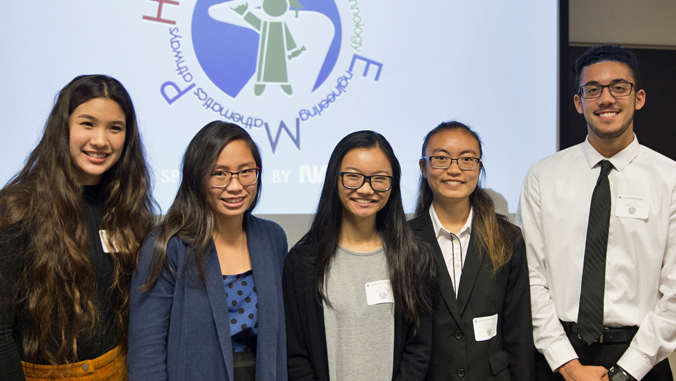
The University of Hawaiʻi at Mānoa’s College of Engineering was among three national universities selected in 2015 by NASA to strengthen curriculum and curricular pathways in science, technology engineering and mathematics (STEM), and attract, retain and support the success of underrepresented students in their degree programs. The cooperative agreement award for the three-year project that began in 2015, called Hawaiʻi’s Engaged STEM Pathways (HESTEMP), totals $499,534.
HESTEMP aims to establish engaged and sustainable educational pathways for Hawaiʻi’s underrepresented and underserved high school students to help them pursue and achieve advanced STEM degrees. This effort focuses on involving students of Native Hawaiian, Samoan, Micronesian and Filipino backgrounds. HESTEMP’s three NASA-prioritized key projects focus on volcanic aerosols, ocean color and small satellite technology.
Activities have been conducted on Oʻahu and Hawaiʻi Island, in partnerships with Waiākea High School, Moanalua High School, Kapiʻolani Community College, UH Hilo, UH Mānoa Hawaiʻi Space Flight Laboratory as well as NASA Ames Research Center. Organizers have also extended the project to Kauaʻi and have plans to expand to Maui.
The HESTEMP team consists of Dilmurat Azimov, principal investigator and assistant professor of mechanical engineering; Myhraliza Aala, College of Engineering STEM marketing and public affairs officer; Karen Selph and Steve Howell, Department of Oceanography; and Eric Pilger, Hawaiʻi Space Flight Laboratory.
Project progress
Since HESTEMP’s inception two years ago, the number of students (high school, community college and university students combined) involved has increased from 10-12 to more than 100 and the number of key projects has increased from 3 to 10. The project has also increased the number of mentors from 1 to 5 and the number of schools and community colleges involved has increased from 3 to over 9.
One of HESTEMP’s key projects, unmanned aerial systems, has advanced to become a stand-alone NASA-funded project, with extended geography covering not only the Hawaiian islands, but also all Central Pacific Islands.
Seven UH Mānoa and UH Hilo undergraduate students have been awarded fully paid NASA summer internships to be conducted at the NASA Ames Research Center. Four undergraduate students have matriculated to graduate school at UH Mānoa to pursue advanced degrees in STEM.
NASA Johnson Space Center has also become a new project collaborator with significant contributions in terms of funds, consultations and internships.
HESTEMP conference
The second annual HESTEMP conference will be held on May 5, 8 a.m.–4:30 p.m., at Hawaiʻi Institute of Geophysics room 110. There will be engaging student presentations ranging from atmospheric aerosol studies, unmanned aerial systems, advancements in space technologies and ocean color studies. Individuals from NASA Ames Research Center will give a talk on their work and how to become involved in the program.
For additional information on HESTEMP, email Dilmurat Azimov.

